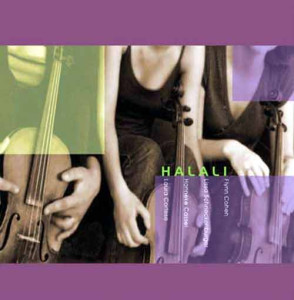 Pat Simmonds wrote this review.
Pat Simmonds wrote this review.
Halali consists of three fiddlers, Hanneke Cassel, Laura Cotese and Lissa Schneckenburger, with Flynn Cohen providing guitar accompaniment. The thriving and bustling session scene in Boston has been bubbling under the surface for a number of years, now rivalling Galway in its depth and quantity. It was only inevitable that the music escape the confines of the bars and onto CD; 2003 has seen the beginning of what can only be a wave of recordings coming out of the Boston area. Halali are very much part of this scene. While the Irish component is more or less its own entity, the Americans have been tapping into it and that coming up with new sounds — Scottish meets Irish meets New England meets contra dance, if you will.
The influences are evident here in the tune selection. For the most part, traditional standards like “Paddy’s Trip to Scotland” and “The Humours of Westport” are thrown in with tunes from Brian Pickell, John Morris Rankin, Michel Bordeleau and Jerry Holland, all played in a style reminiscent of the big Scottish fiddle bands popular in recent years. There is a misappropriated title, “The Roaring Barmaid,” which is actually “The Butlers of Glen Avenue” by the Manchester banjoist Tony Sullivan, an annoying mistake that seems to have taken hold in recent years. I’m sure Tony would appreciate the recognition. There are also a number of tunes written by members of the group.
The fiddles all resonate very well, everything is in tune, the guitars and pianos are suitably restrained and the tempi are solid. Although I found the songs a little rushed, it’s good playing all round, really. Mr. Cohen’s playing is the highlight on this album; his rock solid rhythm and inventive chord progressions are present throughout, reflecting the many musicians that he has worked with over the years.
While the music is a great reflection of the New England scene, it lacks some of the grittiness or ethereal qualities of its more traditional contemporaries. Jimmy Noonan’s recent release, for instance. There is a softness to this record that is immediately recognisable as being modern American, and one wonders what the outcome would be if the musicians decided to further explore that aspect of their cultural heritage. There are nine pieces in all, a little short perhaps? Not really. The record cruises past the ears at a relaxed pace, and would be a good buy at the gig or festival.
(Footprint Records, 2003)
